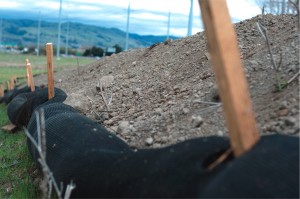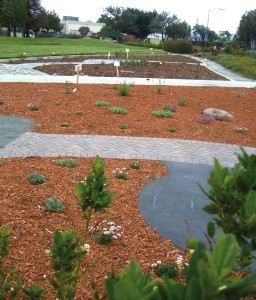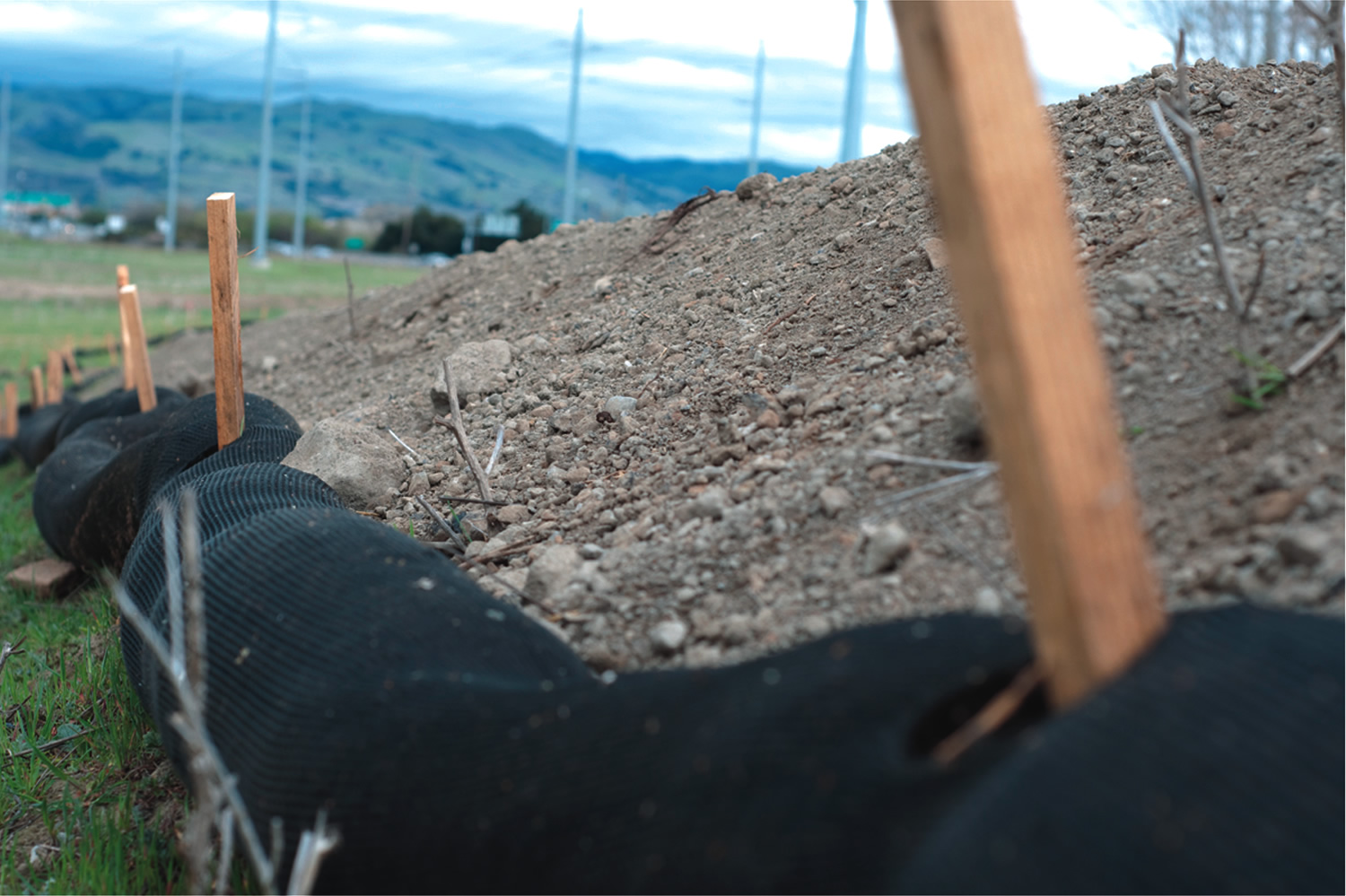Mulch and compost products help solve maintenance problems in the short term, and provide long-term ecosystem benefits for the City of San Jose.
Paul Hagey
BioCycle May 2012, Vol. 53, No. 5, p. 31

Compost sock prevents sediment from pouring down the slope at the newly constructed Highway 237 Bikeway. The slope will be stabilized with a seeded compost blanket.
San Jose is located at the southern terminus of the San Francisco Bay and with just over a million residents, is the tenth largest city in the U.S. Like many communities throughout the country, San Jose is faced with multiple pressures, including budget challenges, staffing limitations and regulations to control storm water runoff into surrounding surface waters. In San Jose’s case, that surface water is the San Francisco Bay, which currently exceeds “State Water Quality standards for pesticides, invasive species, mercury and other metals and toxic substances,” according to the US EPA.
As part of the city’s compliance with federal NPDES storm water management requirements, San Jose is exploring sustainable landscape opportunities to reduce runoff, increase storm water infiltration capacity and capture toxins before they reach local waterways. These activities are becoming integrated with use of recycled organics, which Young has been promoting for many years. “Our market support program started in 1994 with Agriculture In Partnership, where San Jose provided funding for agricultural research using compost and mulch from large-scale composters,” she notes. “The program transitioned over time to include more diverse audiences and applications, such as public landscapes, professional landscapers, CalTrans [the state Department of Transportation] and residents. Our bottom line goal is that the more landscapes there are with healthy soils, water and plants, the more our whole ecosystem is enhanced and able to function as a regional resource.”
Increased use of compost and mulch is being driven by budget cuts that are resulting in reduced staff and maintenance resources. Because compost and mulch made from the city’s organic waste stream can solve multiple problems, diverse stakeholders can meet their goals — and enhance ecosystem services — through a single project application. For example, mulch provides weed abatement, as well as water conservation and reduction in pesticide use, solving budget and staffing challenges for San Jose’s Parks, General Services and Transportation departments. These same applications are also supporting ecosystem services that help to meet San Jose’s Citywide Green Vision and regional storm water permit goals that connect copermitees throughout the region.
The key, explains Young, is to focus on compost use as a solution to department or agency challenges: “We in the industry know about compost’s long term benefits, but in conversations with other city agencies, we need to discuss what they care about for their current work plan. For example, the Parks Department was requesting mulch to cover unmaintained lawn areas that were becoming weed patches. We were able to suggest the installation of sustainable landscapes that would need less maintenance in the long run, and provide more diverse ecosystem benefits. The need for solutions to short term problems is creating an openness to innovations that in turn open the door for recycled content materials.”
Education And Outreach
To help facilitate education and outreach — both internally within city agencies and externally with landscapers and county and state agencies — San Jose contracted with a compost consultant, Ron Alexander of R. Alexander Associates, Inc., and partnered with two local compost processors, Zanker Road Resource Management (via its Z-Best composting subsidiary) and Allied Waste-Newby Island, which process organic materials from the city and other local agencies. The team came together to share the costs and resources of reaching out to landscape architects working on public and private projects.
“Having a third-party expert to support the education process allows us to meet with landscape professionals in public and private sector roles who may be hesitant to meet with compost vendors because of the perceived sales pitch,” says Young. Alexander is in his third consecutive year consulting with the city and processors, as all of the partners recognize the benefits of his work in the region. One of the key benefits is the tailored support that the team is able to give landscape architects in reviewing and revising their landscape specifications. This step alone has made an immediate difference by allowing compost and mulch to be specified in a wide variety of projects.
“A case in point is a meeting we had with the City’s General Services and Parks Departments,” notes Young. “Compost samples were provided, and Ron gave a presentation on how to use a variety of recycled content materials — including compost, mulch, drain rock and sand — to create sustainable landscapes. He discussed storm water management benefits, specifications for compost and mulch and provided project examples. A Parks Department representative mentioned that they were in a phase of a bikeway construction project [Highway 237] where compost socks and blankets could be used as best management practices (BMPs) to meet construction requirements. They said if it works and is cost-effective, it makes a lot more sense than using straw and other less beneficial BMPs in city projects.”
The bikeway project will enable the city to assess impacts toward meeting NPDES compliance goals. These integrated projects are also allowing for new and enhanced relationships between departments and agencies that have not worked together in the past. “We are just beginning to see the benefits of these working alliances, which promise greater innovation in the future,” says Young. “The integrated presentation of solutions and goals creates less confusion and helps departments understand the relationships and environmental impacts inherent in their projects.”

Demonstration gardens at a San Jose park show how compost and proper plant choices can minimize pests and how mulch can be used to prevent weed growth and conserve water.
Demonstrating Versatility
One of the best compost marketing tools is to let potential users see how compost can work in various applications. Applying compost on city sites allows each project to act as a demonstration that is open for others to visit, with the data available for sharing. Three key project sites were developed in San Jose, and will help serve as catalysts for compost use. The new demonstration projects include a CalTrans roadside improvement site, two residential demonstration gardens at a San Jose city park, and the bike path project (referenced above).
The CalTrans site, located at the intersection of State Highway 85 and Winchester Boulevard in San Jose, is where the city has contracted with University of California, Davis researcher Vic Claassen to show how different uses of compost can enhance water conservation (through its water-holding capacity), erosion control, weed abatement via mulching, and improved plant health. The plants were installed this year. The concrete-hard, rocky, unamended soil that characterizes much of the site makes landscaping tough, and is indicative of the type of site that prompts recurring landscaping costs for Cal Trans in replaced vegetation and irrigation.
Claassen has developed a trench system at the site where bands of tilled-in compost infiltrate and hold rainwater and keep plants irrigated during the waterless summers that characterize California’s climate in this part of the state. The tilled-in compost also will reduce the erosive force and volume of surface water runoff, thus minimizing irrigation costs and supplemental erosion control, he explains. Claassen is installing soil probes that will allow him to monitor the site, and create results that will be provided to Cal Trans and other landscape managers.
San Jose received a $200,000 grant from the California Department of Pesticide Regulation that includes development of two demonstration gardens at one of its city parks. The new installation will show how compost and proper plant choices can minimize pests and how mulch can be used to prevent weed growth. The design plans are available to landscapers and homeowners, and the gardens will be used as a training site to educate residents about sustainable practices, including compost production and use. The city sponsored an open garden in late April that included tours and residential landscape classes taught by designers. “In addition to the landscaped gardens, there is an IPM project that is testing different types of mulches for weed abatement and water conservation,” says Young. “The city is excited about the potential to inspire conversion of large numbers of home landscapes, which will enhance the entire watershed in this area.”
The Highway 237 Bikeway project is adjacent to the city’s wastewater treatment plant. The Bay is visible a couple hundred yards father to the north. On a newly cut section of the bike path, a 20-feet-wide swath of dirt-pack at the moment, a compost sock, about 10 inches in diameter and full of compost resembling a thick snake, curves off into the distance. A few feet below the lip of the bike path on the roughly two-to-one-angled short slope, the full sock, its shell made of biodegradable material and tacked to the slope with untreated fir stakes spaced roughly two feet apart, is working perfectly. Soil on the uphill side bunches up against the tube of compost, showing how the sock stabilizes the slope by conforming to it and prevents sediment from pouring down. The slope of the trail will be protected with a seeded compost blanket (see sidebar for compost spec). The compost solution is cost-competitive with silt fence and hydroseeding and could be used in all future projects that involve this type of construction mitigation.
Compost Supplies
Zanker’s Z-Best Composting facility is located in Gilroy, about 30 miles south of San Jose. Allied’s Newby Island composting site is in Milpitas, about 8 miles from San Jose. Z-Best processes 500 tons/day of green waste and 350 tons of food waste/day, says Alex Sharpe, Zanker’s compost marketing manager. In 2011, Zanker distributed about 120,000 tons of compost made from about 175,000 tons of green waste. Sharpe estimates that Zanker has made about 5,000 yards of special engineered soil mix for storm water applications in the last three years. Z-best makes the custom blends by mixing a sandy loam soil with its green waste compost to meet requested specs.
Glenn Bohling, marketing manager for the Newby Island composting facility, also says compost demand is on the rise, and that engineered soil mixes will be an increasing component of Newby Island’s compost products. The facility is averaging a 25 percent increase in sales annually, he says, which is spurred by an increase in demand for compost as an erosion control and weed mitigation agent. Indicative of the growing market, Newby Island develops different compost products for different uses, explains Bohling: a one-eighth-inch-plus fine silt used primarily for storm water bioswales, a one-quarter-inch-minus variety that has a tendency to resist compaction and is used as a topdressing for golf courses and city parks, and a three-eighths-inch-minus variety that is used as a soil amendment for its benefit to soil structure.
Part of San Jose’s outreach is to promote compost use regionally. The project team explains to audiences throughout the Bay Area that all of the landscapes that feed into this watershed system support the same goals of clean water, healthy plants and erosion and flood protection. “As we impact projects throughout the region, we are meeting mutual goals of waste diversion, storm water management and enhanced ecosystem services,” concludes Young.
Paul Hagey is a freelance writer based in Oakland, California.










